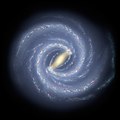| Leo I | |
|---|---|
 Leo I appears as a faint patch to the right of the bright star, Regulus. | |
| Observation data (J2000 epoch) | |
| Constellation | Leo |
| Right ascension | 10h 08m 27.4s [1] |
| Declination | +12° 18′ 27″ [1] |
| Redshift | 285 ± 2 km/s [1] |
| Distance | 820 ± 70 kly (250 ± 20 kpc) [2] [3] |
| Apparent magnitude (V) | 11.2 [1] |
| Absolute magnitude (V) | −12.0 [4] |
| Characteristics | |
| Type | E;dSph [1] |
| Mass | (2.0 ± 1.0) × 107 M☉ |
| Size | 2000 ly [5] |
| Apparent size (V) | 9.8′ × 7.4′ [1] |
| Notable features | Milky Way satellite |
| Other designations | |
| UGC 5470, [1] PGC 29488, [1] DDO 74, [1] A1006, [1] Harrington-Wilson #1, [1] Regulus Dwarf [1] | |
Leo I is a dwarf spheroidal galaxy in the constellation Leo. At about 820,000 light-years distant, it is a member of the Local Group of galaxies and is thought to be one of the most distant satellites of the Milky Way galaxy. It was discovered in 1950 by Albert George Wilson on photographic plates of the National Geographic Society – Palomar Observatory Sky Survey, which were taken with the 48-inch Schmidt camera at Palomar Observatory. [6] [7]
